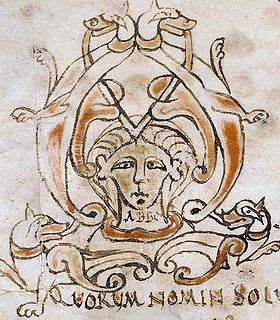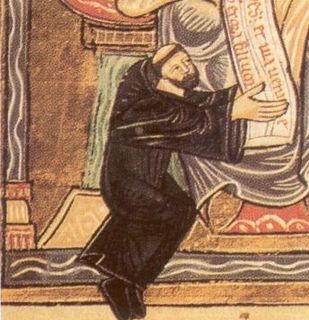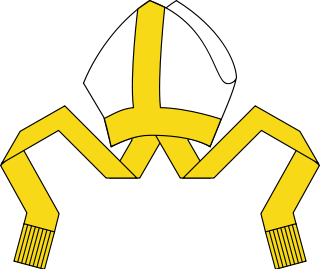Related Research Articles
Pope Celestine I was the bishop of Rome from 10 September 422 to his death on 1 August 432. Celestine's tenure was largely spent combatting various ideologies deemed heretical. He supported the mission of the Gallic bishops that sent Germanus of Auxerre in 429, to Britain to address Pelagianism, and later commissioned Palladius as bishop to the Scots of Ireland and northern Britain. In 430, he held a synod in Rome which condemned the apparent views of Nestorius.

Edmund the Martyr was king of East Anglia from about 855 until his death.

Germanus of Auxerre was a western Roman clergyman who was bishop of Auxerre in Late Antique Gaul. He abandoned a career as a high-ranking government official to devote his formidable energy towards the promotion of the church and the protection of his "flock" in dangerous times, personally confronting, for instance, the barbarian king "Goar". In Britain he is best remembered for his journey to combat Pelagianism in or around 429 AD, and the records of this visit provide valuable information on the state of post-Roman British society. He also played an important part in the establishment and promotion of the Cult of Saint Alban. The saint was said to have revealed the story of his martyrdom to Germanus in a dream or holy vision, and Germanus ordered this to be written down for public display. Germanus is venerated as a saint in both the Roman Catholic and Orthodox churches, which commemorate him on 31 July.

Abbo or Abbon of Fleury, also known as Saint Abbo or Abbon, was a monk and abbot of Fleury Abbey in present-day Saint-Benoît-sur-Loire near Orléans, France.

Odo of Cluny was the second abbot of Cluny. He enacted various reforms in the Cluniac system of France and Italy. He is venerated as a saint by the Catholic and Eastern Orthodox Churches. His feast day is 18 November.
Abbo is a male given name and a surname.
Dom Ambrose Griffiths was a Benedictine abbot before becoming a Roman Catholic bishop in the Catholic Church in England and Wales.

Fleury Abbey (Floriacum) in Saint-Benoît-sur-Loire, Loiret, France, founded in about 640, is one of the most celebrated Benedictine monasteries of Western Europe, and possesses the relics of St. Benedict of Nursia. Its site on the banks of the Loire has always made it easily accessible from Orléans, a center of culture unbroken since Roman times. Today the abbey has over forty monks led by the abbot Etienne Ricaud.
Germanus or Germanos (Greek) may refer to:

Dubricius or Dubric was a 6th-century British ecclesiastic venerated as a saint. He was the evangelist of Ergyng and much of south-east Wales.

The Abbey of Saint Maurice, Agaunum is a Swiss monastery of canons regular in Saint-Maurice, Canton of Valais, which dates from the 6th century. It is situated against a cliff in a section of the road between Geneva and the Simplon Pass. The abbey itself is a territorial abbacy and not part of any diocese. It is best known for its connection to the martyrdom of the Theban Legion, its original practice of perpetual psalmody, and a collection of art and antiquity.

The Roman Catholic Archdiocese of Sens and Auxerre is a Latin Rite Archdiocese of the Roman Catholic Church in France. The Archdiocese comprises the department of Yonne, which is in the region of Bourgogne. Traditionally established in sub-apostolic times, the diocese as metropolis of Quarta Lugdunensis subsequently achieved metropolitical status. For a time, the Archbishop of Sens held the title "Primate of the Gauls and Germania". Until 1622, the Metropolitan Archdiocese numbered seven suffragan (subordinate) dioceses: the dioceses of Chartres, Auxerre, Meaux, Paris, Orléans, Nevers and Troyes, which inspired the acronym CAMPONT. The Diocese of Bethléem at Clamecy was also dependent on the metropolitan see of Sens. On December 8, 2002, as part of a general reorganization of the dioceses of France undertaken, at least in part, to respond to demographic changes, the Archdiocese of Sens-Auxerre ceased to have metropolitan rank and became a suffragan of the Archdiocese of Dijon, which became the centre of a new ecclesiastical province for the Burgundy administrative region. Consequently the Archbishop of Sens-Auxerre no longer has the privilege of wearing the pallium. The current archbishop is Yves François Patenôtre.

The diocese of Auxerre is a former French Roman Catholic diocese. Its historical episcopal see was in the city of Auxerre in Burgundy, now part of eastern France. Currently the non-metropolitan Archbishop of Sens, ordinary of the diocese of Sens and Auxerre, resides in Auxerre.
Saint Aunarius (Aunacharius) (c.540–c.603) was bishop of Auxerre during the 6th century.

The Abbey of Saint-Germain d'Auxerre is a former Benedictine monastery in central France, dedicated to its founder Saint Germain of Auxerre, the bishop of Auxerre, who died in 448. It was founded on the site of an oratory built by Germanus in honor of Saint Maurice.
Aaron of Auxerre was a bishop of Auxerre. He has been beatified by the Roman Catholic Church, and his relics are venerated in the Church of Saint-Germain in Auxerre, where his feast day is celebrated on 28 September.

Goeric of Metz, also known as Abbo I of Metz, Goericus of Metz, and Gury of Metz, was a bishop of Metz. He is venerated as a saint in the Eastern Orthodox and Roman Catholic Churches.

Martin Marty was a Swiss-born Benedictine missionary and bishop in the United States. He was the first Abbot of St. Meinrad Monastery in Indiana, the first vicar apostolic of Dakota Territory, where he ministered to the Lakota Sioux; and the second bishop of the Roman Catholic Diocese of Saint Cloud. His zeal for the Indian Missions earned him the title, "The Apostle of the Sioux".

Joseph John Gerry, O.S.B., is an American Benedictine monk and prelate of the Roman Catholic Church.
Arnulf was the bishop of Orléans from 970 until his death. He is known for his feud with Abbo of Fleury, and his denunciation of the papacy.
References
- ↑ Saint Abbo (Catholic Online)
- ↑ Martyrologium Romanum (Libreria Editrice Vaticana, 2001, ISBN 88-209-7210-7)